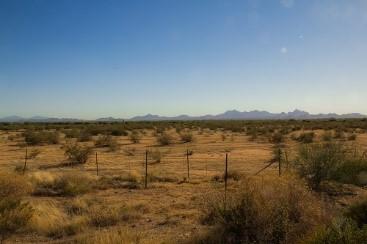
Credit: Alli Benjamin, APR
The Southwest Environmental Health Sciences Center, headquartered at the University of Arizona College of Pharmacy, has been awarded a five-year $6.9 million grant to continue to study the effects of arsenic, air particulates, sunlight and other environmental factors affecting the health of individuals residing in arid climates worldwide.
The center, which has been funded continuously since 1994, received the grant from the National Institute of Environmental Health Sciences.
"For nearly 25 years, we've committed ourselves to exploring and understanding underlying human diseases that are influenced by environmental exposure, particularly in desert climates," said Nathan Cherrington, PhD, director of the center. "Our overarching goal has never wavered — to improve the lives of the people of Arizona, the Southwest and in arid environments worldwide."
A large portion of the funding will be given to the UA's facilities, Dr. Cherrington said. The center has three core initiatives that support collaborative, multidisciplinary research. The funds support infrastructure for state-of-the-art facilities and equipment in research enterprises, including a cellular imaging facility core, a genomics facility core and an integrated health sciences facility core. The research themes, which span across each of the facility cores, include environmental exposures among Southwest populations, environmental lung disease and adaptive responses to environmental stress.
"The new grant funding provides an opportunity for us to expand collaboration with communities, to help determine the potential health effects from their environmental exposures and identify ways to reduce hazardous exposures," said Jeffrey Burgess, MD, MS, MPH, associate dean of research and professor at the UA Mel and Enid Zuckerman College of Public Health and co-director of the Integrated Health Sciences Facility Core at the Southwest Environmental Health Sciences Center. Dr. Burgess has been a member of the center for more than 20 years.
The center includes 49 investigators, 13 staff members and four key personnel from 17 departments within six colleges at the UA, and one investigator from Northern Arizona University.
"Research doesn't happen with a scientist sitting alone in a lab; it takes a multitude of people who bring their areas of expertise to focus on a problem. We provide expertise in statistics and big data and technologies to aid investigators at the Southwest Environmental Health Sciences Center with their research," said Dean Billheimer, PhD, professor of biostatistics at the UA Zuckerman College of Public Health, co-director of the Integrated Health Sciences Facility Core and leader of the Data Science Resource at the center.
"The research conducted by Southwest Environmental Health Sciences Center's faculty exemplifies the UA's global impact," said UA President Robert C. Robbins, MD. "By embracing collaborations that cut across several disciplines, they generate new knowledge that is rooted in our unique locale and positively impacts not only our region, but other arid locations in the Southwestern United States and across the world."
The center's administration provides seed money for pilot research projects to explore new areas of environmental health research, enabling researchers to acquire the essential preliminary data to pursue long-term extramural funding. Faculty members in the center train and mentor junior faculty members in environmental health sciences and help young scientists and clinician-scientists build foundations for careers in research areas funded by the National Institute of Environmental Health Sciences.
Engaging Southern Arizona students, health-care providers, tribal and underserved communities
Another important center component is the Community Engagement Core, which educates Southern Arizona tribal and underserved communities. Faculty and staff members in the core disseminate environmental health information aligned with center research and areas of interest, including air pollution, lung disease, asthma, cancer, the effects of ultraviolet radiation and arsenic exposure, among other topics.
"We've been able to disseminate environmental health research and information through effective forums, including science cafes, which are public forums held throughout Southern Arizona with experts addressing environmental health issues," said Marti Lindsey, PhD, community engagement program director. "Additionally, environmental health curricula and lessons are made available to teachers, health-care providers, community members and students. It's been an effective way to engage our communities and provide environmental health education concepts and materials."
"In terms of environmental health, the University of Arizona remains in the upper echelon of leading research universities," Dr. Cherrington added.
###
The NIEHS is a section of the National Institutes of Health. Funding for the UA center is provided through grant No. P30 ES006694.
About the University of Arizona College of Pharmacy
The University of Arizona College of Pharmacy is the premier pharmacy college in the Southwest, and one of the top in the nation, focused on drug discovery, toxicology, pharmaceutics, outcomes sciences, pharmaceutical education and research through interprofessional training and collaborative public/private partnerships. Preparing pharmacists and pharmaceutical scientists in undergraduate, professional, graduate and post-doctoral programs, the college embraces an entrepreneurial spirit, providing tailored educational opportunities to broaden students' experiences. As the first health sciences college at the University, the college has a long history of improving science and health, both in Arizona and around the world. For more information, please visit pharmacy.arizona.edu
About the University of Arizona Health Sciences
The University of Arizona Health Sciences is the statewide leader in biomedical research and health professions training. The UA Health Sciences includes the UA Colleges of Medicine (Phoenix and Tucson), Nursing, Pharmacy and Mel and Enid Zuckerman College of Public Health, with main campus locations in Tucson and the growing Phoenix Biomedical Campus in downtown Phoenix. From these vantage points, the UA Health Sciences reaches across the state of Arizona and the greater Southwest to provide cutting-edge health education, research, patient care and community outreach services. A major economic engine, the UA Health Sciences employs approximately 4,000 people, has approximately 800 faculty members and garners more than $140 million in research grants and contracts annually. For more information: uahs.arizona.edu
Media Contact
Alli Benjamin
[email protected]
520-626-3389
http://uahs.arizona.edu/




